Have you ever had a pimple ruin your day? Many people deal with persistent acne and struggle to find natural alternatives to getting rid of blemishes. To help treat your acne, I formulated this charcoal soap as a powerful tool that will help draw out toxins while also being safe for the face.
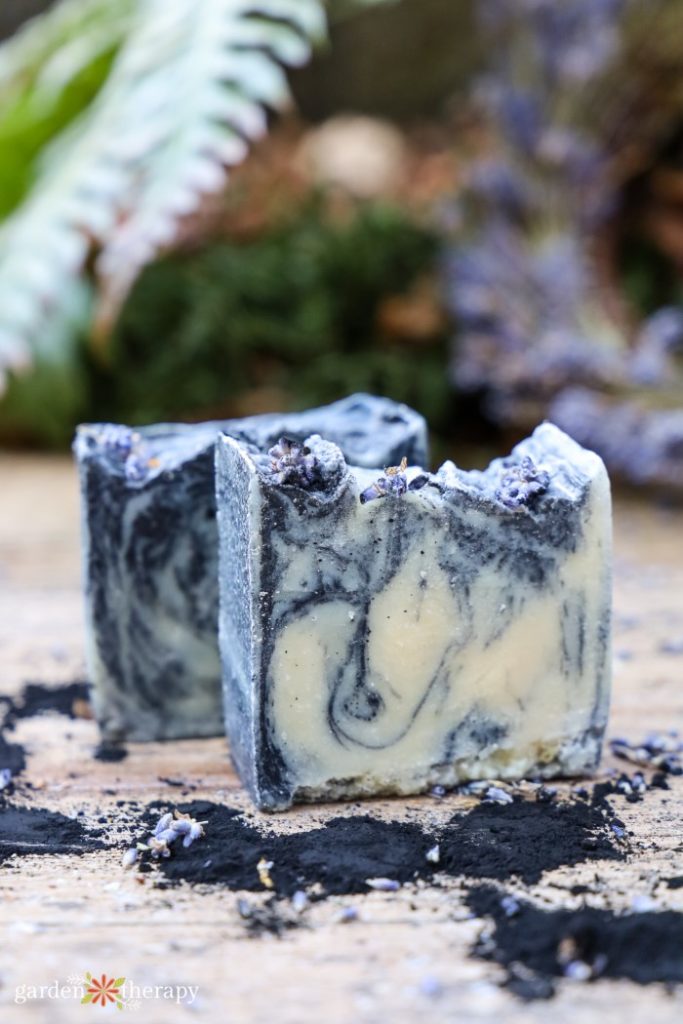
This charcoal soap bar for the face is an all-natural yet powerful cleanser to add to your everyday skincare routine. It is made using my lather soap blend swirled with activated charcoal for a deep facial cleanse.
I first formulated this charcoal soap bar after I noticed I was having some irritation and blemishes from wearing a mask. However, it would work for anyone who experiences acne and blemishes on the face or on the body.
Performing a deep cleanse is only half the battle when it comes to acne. I also wanted to include some overall tips on how to prevent and treat acne. But first, let’s see what we’re working with!
This post will cover…
- What is Maskne?
- How to Treat Acne
- Charcoal Soap Benefits for Acne
- Make Your Own Charcoal Soap
- Materials
- Ingredients
- Make It!
- Aftercare Routine
- Frequently Asked Questions About Charcoal Soap
- More Soap Recipes

What is Maskne?
When I started wearing a mask, I started getting pimples on the tip of my nose. As someone who very rarely gets pimples anymore, it was certainly out of the ordinary.
Have you heard of maskne before? This is the acne or skin irritation as a result of wearing a mask.
Since masks trap in oils and sweat, we become much more prone to blemishes. Whenever our pores get clogged from things such as dirt or sweat, it blocks the ability for sebum (our body’s natural oils) to rise to the surface. When our pores aren’t cleaned, they get blocked and infected, resulting in acne and blackheads.
Masks can either worsen someone who already has acne or even create new problems for someone like me who doesn’t often see a pimple pop up.
The idea of maskne is actually not as new as we think! Think of hockey or football players, or even our doctors, nurses, and other healthcare workers. They have been wearing masks for years and know all about maskne.
While I made this soap to deal with my bout of maskne, I know plenty of people experience pimples on the daily basis. This charcoal soap will work wonders to help minimize breakouts and prevent future ones from happening.
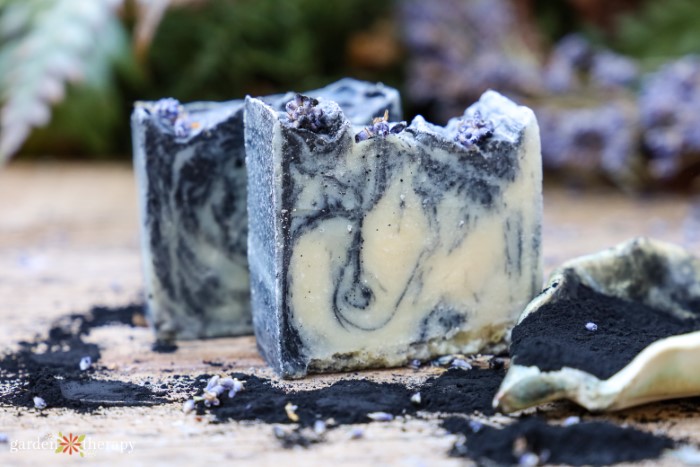
How to Treat Acne
Luckily, there are a few things we can do to prevent and treat acne or its severity. Here are some acne tips to try:
- Wash your face. Wash your face with warm water (not hot) and massage in a circular motion for 20-30 seconds. Avoid excessive washing as this can actually make acne worse by forcing the body to produce more oil. Wash no more than twice a day.
- Avoid wearing makeup. Wearing makeup for long periods of the day can get trapped inside your pores and worsen acne. Consider only applying makeup to your eyes and minimal makeup on the skin and active breakouts. If you do wear face makeup, make sure it’s non-comedogenic.
- Change your skincare routine. You will want to avoid strong and harsh products. Instead, opt for products with fewer ingredients. This charcoal bar soap recipe is great for the skin because it is all-natural and contains no harsh chemicals or additives.
- Keep hydrated. Dehydration can lead to your body generating more oil. It also gives skin a dull appearance and can cause inflammation.
- Moisturize your skin. Not only does it moisturize your skin, but it will also protect your skin from further irritation. Check out my aftercare suggestions at the end of this post for more on moisturizers.
- Let your skin breathe. Now that you have cleansed and moisturized, avoid touching your face. Keeping pores unobstructed will help your breakouts heal.
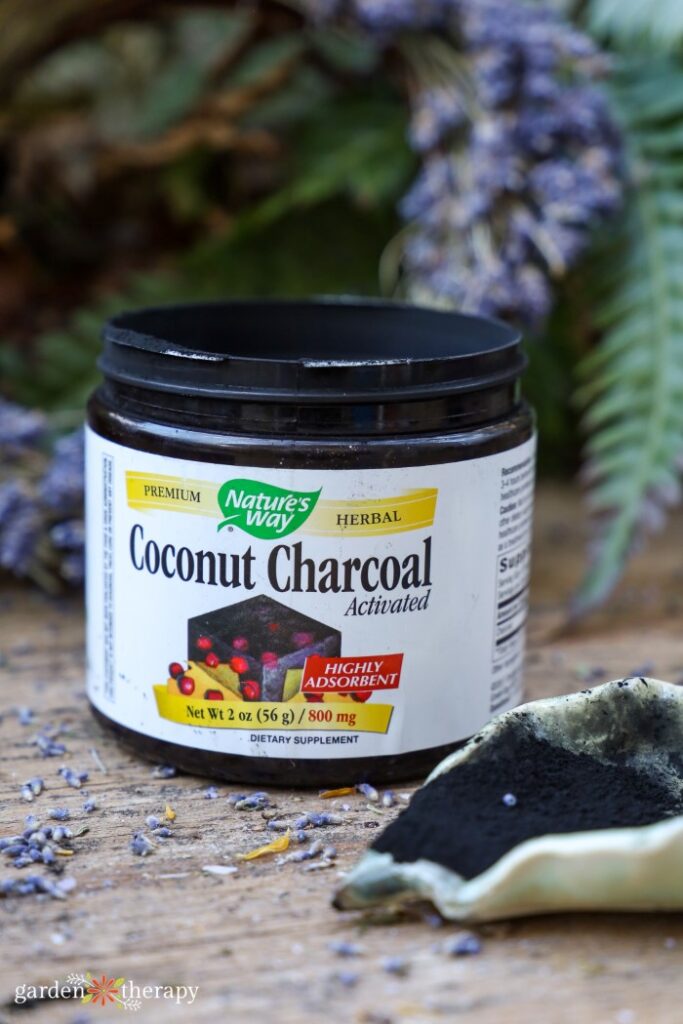
Charcoal Soap Benefits for Acne
The magic ingredient in this charcoal soap bar recipe is activated charcoal. Activated charcoal is amazing for face soaps because of its ability to draw out toxins.
To make activated charcoal, manufacturers heat it at an extremely high temperature which actually changes its internal structure. It does not resemble anything you would burn in your own firepit or barbecue.
Since it has a negative charge, it can actually help to draw our positively charged molecules such as toxins and grease. When used on the face, it acts as a deep cleanser to draw out microparticles from the skin, including dirt, chemicals, toxins, dust, and bacteria. Once they are drawn to the surface, it makes the removal of the toxins much easier.
While it may have powerful toxin-clearing properties, it doesn’t absorb the vitamins and nutrients that your skin needs. It is also inert, meaning it is unlikely to cause allergic reactions or irritate the skin if used properly.
You may even notice your pores are minimized after using activated charcoal. Dirt and oil make your pores appear larger. By removing them, you will notice smaller pores and smoother-looking skin.
All in all, activated charcoal is a 100% natural ingredient with powerful properties. It was a no-brainer for me to add it to my soap recipe!
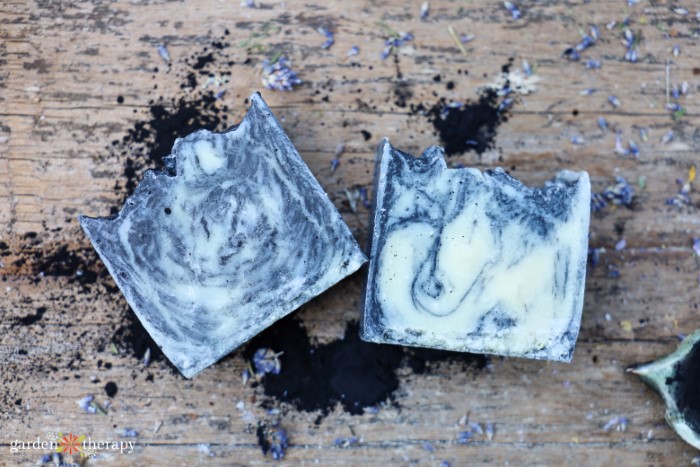
Make Your Own Charcoal Soap
This recipe is a 75/25 blend of coconut and olive oil. It can be a bit drying for people with dry skin, but works great for those with oily skin and those who get acne. You will get a great lather to really clean the face thoroughly.
Materials
- Kitchen scale
- Infrared thermometer
- Double boiler made of stainless steel (not aluminum) soap making pitcher and a pot of water
- Pyrex or heatproof glass measuring cup(4-cup)
- Immersion blender
- Safety gear (rubber gloves, face mask, apron, eye protection, etc.)
- Loaf-style soap mold
Ingredients
- 532 ml (18 oz) coconut oil
- 177 ml (6 oz) olive oil
- 290 ml (9.8 oz) distilled water
- 124 ml (4.2 oz) lye
- 60 ml (2 oz) grapeseed oil
- 15 ml (0.5 oz) shea butter, mango butter, or cocoa butter
- 15 ml organic lavender essential oil
- 1 tsp activated charcoal
- 1 tsp bentonite clay
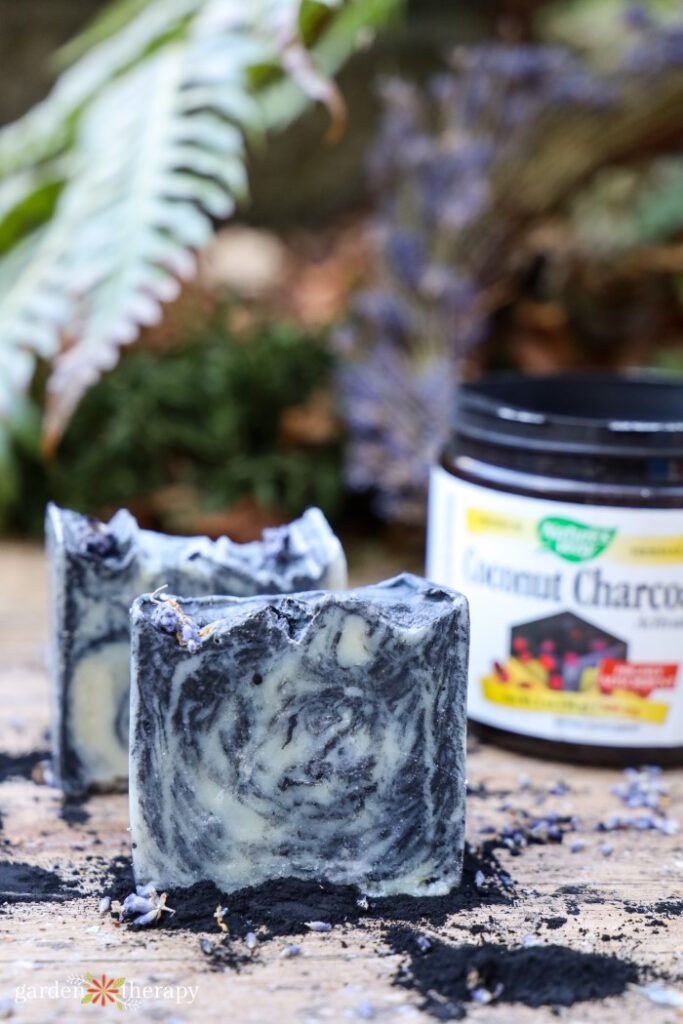
Make It!
These step-by-step instructions are great for those who have made soap before. If it is your first time, please find more detailed instructions and photos on how to make cold-process soap, but be sure to follow this recipe’s ingredients.
- Firstly, make sure you keep your eyes and skin safe by wearing goggles and work gloves.
- Next, grab a kitchen scale. Use it to weigh all your ingredients exactly as told in the recipe.
- Measure your bentonite clay and activated charcoal into two separate small containers. I find shot glasses or ramekins work well. Then, set aside.
- Slowly heat your oils over the stove in a stainless steel pot.
- Get a heat-resistant 4-cup measuring cup and add water to it. Now, add your lye very slowly while stirring constantly. It is best to do this in a well-ventilated area as there will be very strong fumes you will not want to breathe in.
- Next, place your lye mixture in an ice bath to cool to 115°F. Your oils should also measure at 115°F, so you can reheat the oils if necessary.
- Next, pour the lye mixture into the oils by using an immersion blender.
- Continue blending until your mixture reaches a light trace.
- Then, blend in your lavender essential oils. Pulse with the blender a few times. You’ll want to work quickly as this will speed up the trace.
- To make the marbled effect, remove a couple of tablespoons of your soap and mix it with the charcoal and then the bentonite clay. Once thoroughly mixed, scoop the batter back into the bowl. Use a spatula to pull it through the mixture three times in different directions to create swirls.
- Pour your mixture into a soap mold. If you don’t have a soap mold, a cleaned and dried 1L milk carton will also work.
- Cover your mold with towels and cardboard, then set it somewhere warm (such as the top of the fridge) for 48 hours.
- After 48 hours, remove your soap from the mold. Cut into equal sections.
- Lastly, place your soap on a wire rack and allow it to cure in a cool and dark place for 6 weeks.
Aftercare Routine
Since this charcoal soap is a deep cleanser, you will want to make sure you are following it up with a good aftercare routine. If you have been suffering from acne, chances are your skin balance is off.
I use my own rosewater toner to naturally restore my skin’s pH. Since we have stripped away the acid layer on top of our skin with a good cleansing, the toner will help to add a new protective layer to the skin.
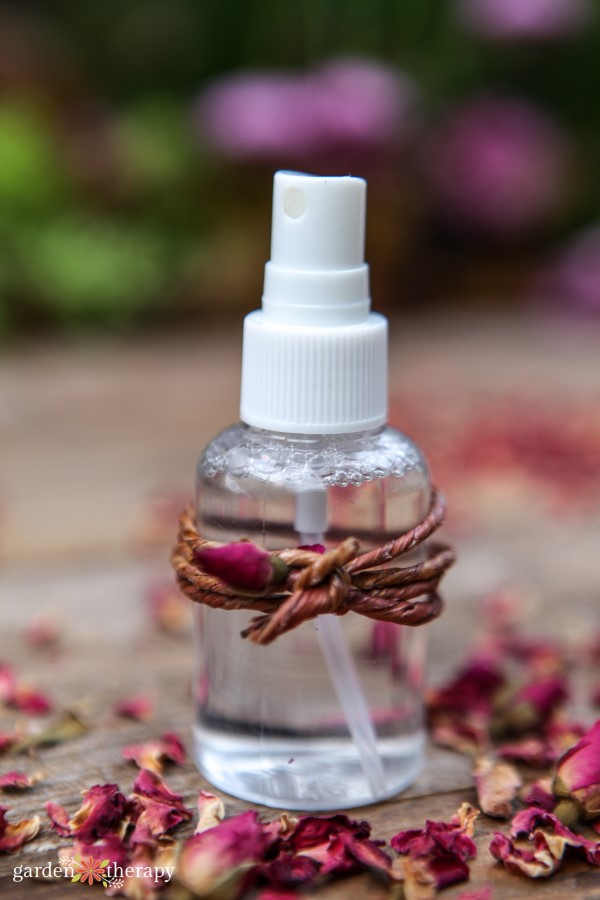
After toner, you will need to moisturize your skin. Even if you have oily skin, it is essential to add moisture back after stripping away our skin of its natural oils. And as I mentioned before, it will also help to reduce irritation for future mask use.
I liked to use my natural lotion recipe after washing my skin with charcoal soap. The lotion is formulated to absorb quickly, not clog pores, and moisturize without creating a heavy feeling.
Altogether, the charcoal soap, rosewater toner, and natural lotion have been my saviour for acne these past few months. Give them a go, and you should notice a difference in your skin too!
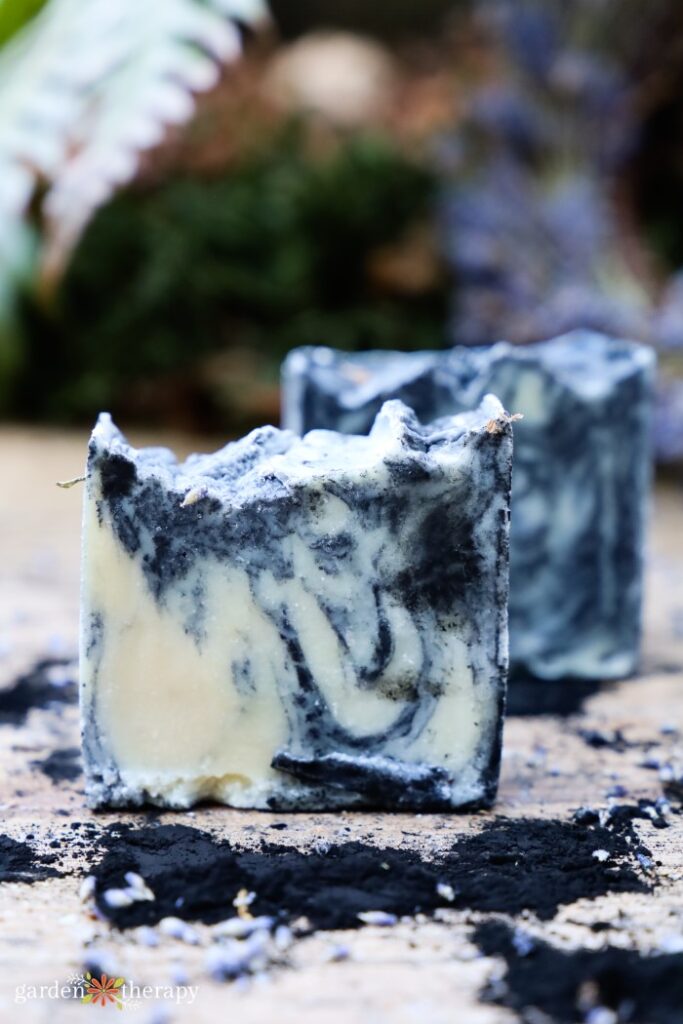
Frequently Asked Questions About Charcoal Soap
Unlike regular charcoal, activated charcoal has gone through a vigorous activating process at very high temperatures. It can be used to detox the skin and help to remove dirt and impurities from the skin. This makes it an excellent tool for fighting acne and blemishes.
Charcoal soap is considered safe for use. However, it’s quite good at its job of attracting oils and impurities. This makes it great for those with oily skin but less ideal for those with dry or sensitive skin. Washing once a day is perfectly fine for most people, but people with dry or sensitive skin can use it less frequently if they notice more dryness than usual.
Wash your face as normal, lathering the charcoal soap for 20-30 seconds. Those with very oily skin can massage the soap on the face for a minute.
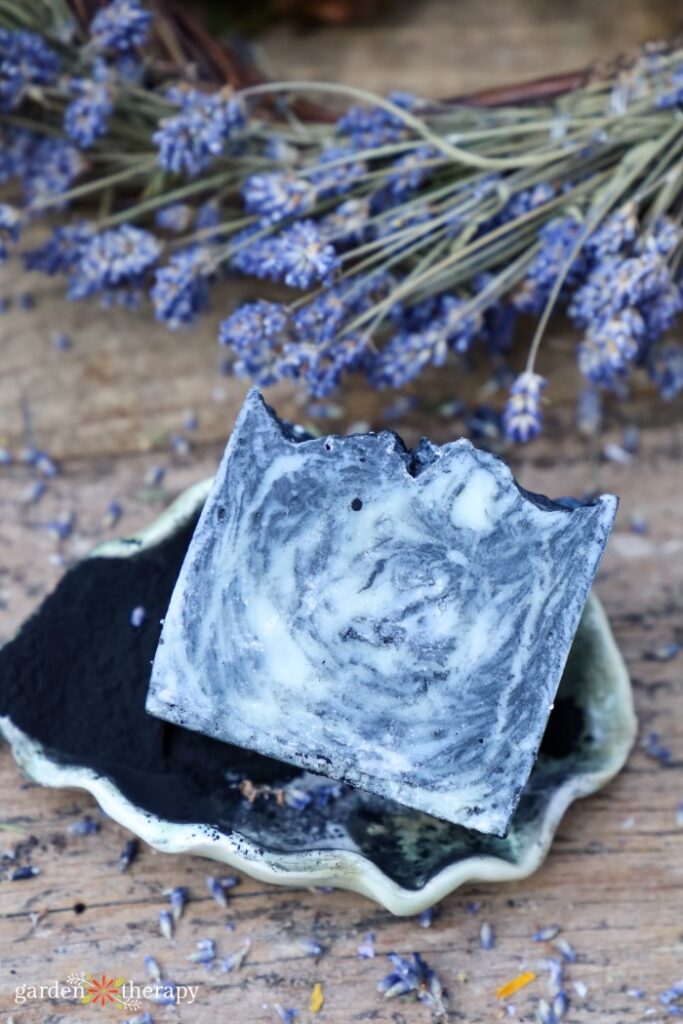
More Soap Recipes
- Creamy Earl Grey Infused Bergamot Soap
- Homemade Cheery Sunflower and Tumeric Soap
- Matcha Green Tea Soap Recipe
- Slightly Masculine Lime and Cedarwood Soap Recipe
Charcoal Face Soap Recipe + How to Treat Acne with It
Equipment
- Double boiler, soap making pitcher, and a pot of water.
- Heat proof measuring cup (4-cup)
- Safety gear (rubber gloves, face mask, apron, eye protection, etc.)
- Loaf-style mold
Supplies
- 532 ml (18 oz) coconut oil
- 177 ml (6 oz) olive oil
- 290 ml (9.8 oz) distilled water
- 124 ml (4.2 oz) lye
- 60 ml (2 oz) grapeseed oil
- 15 ml (0.5 oz) shea butter, mango butter, or cocoa butter
- 1 tsp activated charcoal
- 1 tsp bentonite clay
- 15 ml organic lavender essential oil
Instructions
- Keep your eyes and skin safe by wearing goggles and work gloves.
- Using a scale, weigh all your ingredients exactly as told in the recipe.
- Slowly heat your oils over the stove in a stainless steel pot.
- Add water to a heat-resistant 4-cup measuring cup. Very slowly add your lye while stirring constantly. It is best to do this in a well ventilated area as there will be very strong fumes you will not want to breathe in.
- Place your lye mixture in an ice bath. It will need to cool to 115°F. Your oils should also measure at 115°F.Reheat them if necessary.
- Using an immersion blender, pour the lye mixture into the oils.
- Continue blending until your mixture reaches a light trace or the consistency of pudding.
- To make the marbled effect, remove a couple tablespoons of your soap and mix it with the charcoal. Once thoroughly mixed, add the batter back into the bowl. Use a spatula to pull it through the mixture three times in different directions.
- Pour your mixture into a soap mold. If you don’t have a soap mold, a cleaned and dried 1L milk carton will also work.
- Cover your mold with towels and cardboard, then set it somewhere warm (such as the top of the fridge) for 48 hours.
- After 48 hours, remove your soap from the mold. Cut into equal sections.
- Place your soap on a wire rack and allow it to cure in a cool and dark place for 6 weeks.





